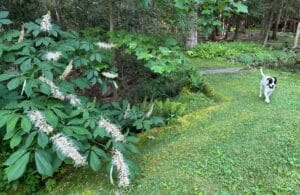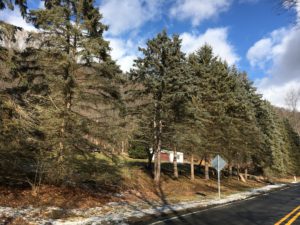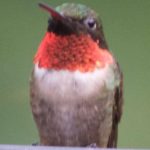Hello fellow readers, We went from a drought spring where we were behind in rainfall to a summer unfolding with too much rain. Trees came down after last week’s storms and flooding, wreaking havoc. Many of them, the Ash trees now dead from the Emerald Ash borer. After the skies cleared, we took a road walk. Jolee loved to run through the runoff along the sides of Cobblewood Road, causing me to run some, too – it was such fun.

Jolee prancing by the Bottlebrush Buckeye
Bottlebrush Buckeyes are a favored understory shrub

Dreaded Canker Disease
We passed the Blue Spruce that remains on Mohican Road — each year, the dieback from the ground up continues from Canker Disease. Eventually, they will be cut down as mine were. But I planted Bottlebrush Buckeye while the trees were in decline, anticipating that sad day. And now the Bottlebrush Buckeyes are in their glory, attracting butterflies and bees.
Bottlebrush Buckeye (Aesculus parviflora) is one of my favorite transition shrubs between woodlands and lawns. It’s native to the southeastern United States to Pennsylvania, reaching 8 to 12 feet high and wide. It grows well in zones 4-8 and is a stunning plant for massing, providing a wave of texture with its hefty leaves and lovely mounding shape.
Aesculus parviflora thrives in full shade to full sun, although it does best with some shade. This flexible fellow prefers well-drained, moist soil but tolerates flooding and moderate drought. The branches are gracefully horizontal and ascend towards the ground, the lower ones touching it.
Cutting lower branches off evergreens exposes gnarly tree knees.

Baby Bottlebrush Buckeye Nuts
It flowers in June through July with picturesque feathery white flowers that look like bottle brushes, hence its common name, which bees, butterflies, and hummingbirds adore. The flowers give way to glossy, pear-shaped nuts (buckeyes) encased in yellow husks. Squirrels love their nuts and are the only animal to eat them without getting sick. As with other buckeyes, the nuts and foliage are poisonous if consumed by humans. And it must be true for deer as they stay clear. Come fall, you’ll adore the sunny yellow color of the leaves.
Many of you know one of my pet peeves is lower branches cut off evergreen trees, which look as bad as wearing knee-high pantyhose with a short skirt. During the decline of the beefy blues, desperate measures overruled my do-not-do. I kept the three beauties going for a few years by limbing up the unsightly branches. That’s where Bottlebrush Buckeye came to be planted below to fill in the gnarly tree’s knees.
Sadness is replaced with the joy of Bottlebrush Buckeyes.
About the time the Bottlebrush Buckeyes grew to be head-high, it was time to cut down the poor Blue Spruces. Still, it was hard to destroy trees whose tops seemed healthy. Sometimes, we must let things go. (But never wear knee-high pantyhose with a short skirt—smile.)

Male Ruby-throated Hummingbirds (Photo by Mike Niven)
Several years later, the sorrow of losing the Blue Spruce is replaced with the joy of the gorgeous swath of Bottlebrush Buckeye. This time of year, what a delight to see swallowtails, monarchs, and bees clustering bottlebrush blooms, all simultaneously on the same plant.
I saw a solitary hummingbird coming in for a taste this morning, and then he hovered by the screen porch. I marveled over its beauty and told him so. My mom loved hummingbirds; feeding them sugar water became one of her late-in-life delights. The beautiful hummer felt like a visit from Mom.
Things are not Hopeless.
Sometimes the cycles of nature are sad—some we caused by tampering with and disrespecting our earth. There’s lots of talk about climate change, and now the media declares a climate crisis due to fossil fuels and implies things are hopeless. It saddens me as I don’t believe instilling fear is a solution to improving things. You can choose to live in love or fear. Fear is paralyzing, while love is nurturing.
This is not to say we remain careless and do not take action, but let’s not give up hope. And let’s hope big business doesn’t put Band-Aids over the neglect by throwing another technology and energy source at the dilemmas that are abusive to our precious planet. By doing so, we aren’t changing our behavior, just how we satisfy it. It seems overwhelming, I agree, but change begins with us.
As Margaret Mead said, “Never doubt that a small group of thoughtful, committed citizens can change the world; indeed, it’s the only thing that ever has.”
Garden Dilemmas? AskMaryStone@gmail.com (and now on your favorite Podcast App.)
I saw a solitary hummingbird coming in for a taste this morning, and then he hovered by the screen porch. I marveled over its beauty and told him so. My mom loved hummingbirds; feeding them sugar water became one of her late-in-life delights. The beautiful hummer felt like a visit from Mom.
There’s much more to the story in the Garden Dilemmas Podcast.
Link to related stories: Spruce Disease Dilemmas and Needcast on Ellie’s Memorial Tree



Hi Mary! Funny that I did the exact same thing. Planted bottlebrush buckeye where my diseased blue spruce was planted and had to be cut down. I also love it! I just took a pic of it in all it’s summer glory today.
Ahh, Lorraine, Gardeners’ minds think alike :^). Thanks for sharing and reading my column, Mary
Thank you for this beautiful story Mary. I loved reading it and listening to it after our visit today. Thank you
Thank you, Cris Cristina, Such a Joy to visit with you today! Working in the vegetable garden together was an added treat as we shared stories of our gardens of life. Grateful for you, dear friend, Mary